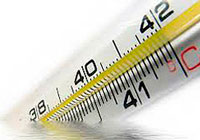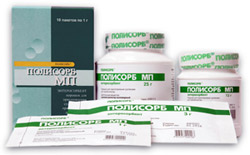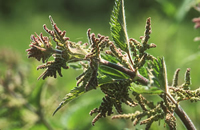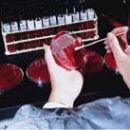What is Tularemia? What are the symptoms and forms of Tularemia? How to treat Tularemia? Answers to these questions you will find in the article.
Content
Tularemia
Tularemia - a disease that flows with intoxication, fever, the development of lymphadenitis and the defeat of various organs.
Sources of infection can be various types of animals. The main ones are rodents (rolling ordinary, water rat, a house mouse, etc.), as well as pets - Sheep, pigs, cattle. Infection carriers can serve bloodsowing arthropods: mosquitoes, blind, fleas, ticks.
The disease is often marked among the hunters separating the skins of rodents, workers of agriculture carrying out straw, strothing overwhelming breads, foresters, workers of antiteria laboratories.
For Tularemia, a multiplicity of transmission of infection is characterized by a person:
- Contact - with contact with patients with animals or their discharge;
- Alimentary - with the use of infected food and water;
- air-dust - when processing infected grain products, forage;
- Transmissive - through the bite of bloodsowing insects.
Tularemia causative agent - Tularemian bacteria - gram-negative cocked or rolling-shaped cells, small, motionless. They are able to persist in an external environment for a long time, especially at low temperatures. For a long time viable in the corpses of infected animals and skins taken from them, in water, food products. When boiling quickly die.
Tularemia causative agent falls into the body through the skin (even not damaged), mucous membranes of the eyes, respiratory tract, gastrointestinal tract. The method of penetration of the pathogen, its pathogenicity, dose and immunobiological reactions of macroorganism determine the development of the appropriate clinical form of the disease. In the place of the entrance gate of the infection is formed primary affect. Following the introduction of the pathogen, its lymphogenic distribution follows. In lymph nodes, the microorganism is reproduced with the development of lymphadenitis. The death of bacteria is accompanied by the release of endotoxin, which enhances the development of the local pathological process, and when entering the blood is caused by blood intoxication. If the barrier function of the lymphatic apparatus is broken, the causative agent penetrates into the blood (bacteremia occurs) and distributed throughout the body. Genesis arises (distribution through the central nervous system) infection with specific lesions of internal organs and body allergization. In the affected internal organs and lymphatic nodes, specific tularemia granulomas are formed.
Symptoms and shapes of Tularemia
The incubation period is an average of 3-7 days. The disease begins suddenly, acutely, without a long period. The chills occurs, the body temperature rises to 38-40°WITH. Stubborn headache, dizziness, muscle pain, weakness.
Patient's face hypereced, Even. Vascular injection Scler and conjunctive hyperemia. Language is taxed. Point hemorrhages can be detected on the mucous membrane of the oral cavity. Sometimes there is an erythematous, roseless or petechial rash. Lymphadenites are detected, the localization of which depends on the form of the disease.
Relative bradycardia and moderate arterial hypertension are noted. Part of patients on the 3-5th day of the disease occurs dry cough, liver increase, spleen.
In peripheral blood, leukocytosis is observed with a shift of the formula to the left, an increase in SE.
The following clinical forms of Tularemia distinguish: bubonic, ulcerative-bubonic, eye-bubonic, anginal-bubonic, tularemia with predominantly damage internal organs and generalized.
Bubonic form It occurs when the pathogen penetrates penetrates and is manifested by inflammation of regional lymph nodes (mainly axillary, femoral, inguinal), where the pathogen accumulates. In the field of the lymph node there is a distinct pain. In the following days, the node significantly increases in size up to 2-10 cm. In the inflammatory process involving the surrounding subcutaneous fiber. Above the bube, the skin is not fast with it and for a long time saves a normal color. The evolution of the Bubon is different. They can dissolve, wear out with the formation of fistula, and sometimes scrugarized.
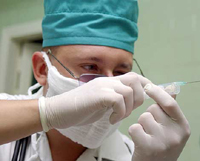 With ulcer-bubonic form Tulyrevia at the site of the introduction of the pathogen from the 1st to the 7th day consistently appear spot, ulcer. The ulcer is covered with a dark crust with a bright peeling rim.
With ulcer-bubonic form Tulyrevia at the site of the introduction of the pathogen from the 1st to the 7th day consistently appear spot, ulcer. The ulcer is covered with a dark crust with a bright peeling rim.
Eye-bubonic develops when the pathogen is hit on the mucous membrane of the eye. For it, a sharply pronounced conjunctivitis with hyperplasia of follicles and erosive-peptic changes on the mucous membranes of the affected eye, accompanied by the release of thick yellowish pus. The general condition of patients is usually severe, the course of the disease is long.
Angic-bubonic Tularemia form occurs when penetration of pathogens with infected food and water. Along with the symptoms of a general nature, sore throat, difficulty difficulty, zea hyperemia. Almonds are enlarged, edema, grayish-white, with necrotic plates, snaps with surrounding fiber. Deep necrotic lesions will significantly destroy the almonds and lead to their scarring. Patients appear cervical, varnish, axillary bubones.
With tularevia with preferably damage in the internal organs, depending on the localization of the process, abdominal and pulmonary forms are isolated.
Abdominal form due to inflammatory process in lymph nodes. Simultaneously with the symptoms of intoxication, grabs-like abdominal pain occur, nausea, re-vomiting, anorexia. In an objective study, soreness in the field of navel and often symptoms of peritonean irritation. Increased liver and spleen.
Lung form Develops due to air-dust transfer path. In this case, the disease can occur in two versions: bronchitic and pneumonic.
The bronchtic variant in which the lymph nodes of the chest is affected, is accompanied by moderately pronounced signs of intoxication, stubborn pains, dry cough. In the lungs, dry wheels are listening. The disease lasts 10-12 days and ends with recovery.
The pneumonic version of the pulmonary form of Tularemia is characterized by acute start, pronounced symptoms of intoxication and protracted flow. Patients complain of dry cough, chest pain. During auscultation, dry and wet small-pushed wheels are listened. Infiltrative changes in lung tissue wear focal, less frequently loblar or dismissed character.
Generalized form Tularevia is noted mainly in weak people. It occurs without local manifestations. The disease is characterized by a stubborn headache, general weakness, myalgia, an increase in body temperature to 39-40°WITH. Patients have confused, nonsense, low blood pressure, deafness of cardiac tones, pulse lability.
In the midst of the disease, many patients are rashes, which is located symmetrically on the upper and lower limbs, face, neck, chest. The complications of this form of Tularerevia include secondary pneumonia, meningitis, meningoencephalitis, infectious psychosis, myocardiodestrophia, polyarthritis.
Treatment and Prevention of Tularemia
In Tularemia treatment, the main role belongs to antibacterial drugs. Most effective streptomycin, tetracyclines, Levomycin. Treatment is carried out for a long time. With a protracted flow, combined antibiotic treatment and vaccine.
Along with etiotropic therapy (Antibacterial drugs) Pathgenetic, which includes disintellation, stimulating and hyposensitizing agents.
Compresses, thermal procedures are used as local treatment. According to the testimony, an autopsy of ventulous bubons.
Important events in Tularemia foci are the extermination of rodents and infection carriers. In the system of anti-teretry events, the protection of water supply, warehouse, food stores occupies important. Persons involved in the works associated with the high risk of infection Tularemia are carried out by vaccine.



